
It's an ongoing debate: how do we eat fish sustainably? Do we leave nature to do its thing and catch wild fish, or farm them to prevent over-fishing?
Currently the Tasmanian salmon farming industry is worth almost $550 million per year, and is set to be a billion-dollar industry within 20 years. But if we don't ensure that sustainable aquaculture practices are in place, what's the point.
This debate surrounding sustainability and salmon farming in Australia has been stoked after ABC's Four Corners episode, Big Fish.
In case you missed the current affairs program, Four Corners delved into the issues related to mass scale near-shore salmon farming in Tasmania -- primarily the spike of water temperature and dangerous drops in water oxygen levels in Macquarie Harbour this year, where companies Tassal, Petuna Seafoods and Huon Aquaculture are intensively farming salmon.
For salmon consumers, the main questions which the program sparked are:
- Is this supposed sustainable method of farming really that sustainable?
- Is eating wild salmon more sustainable?
- Are there health concerns surrounding consuming farmed salmon?
- Should we be eating salmon or fish at all?
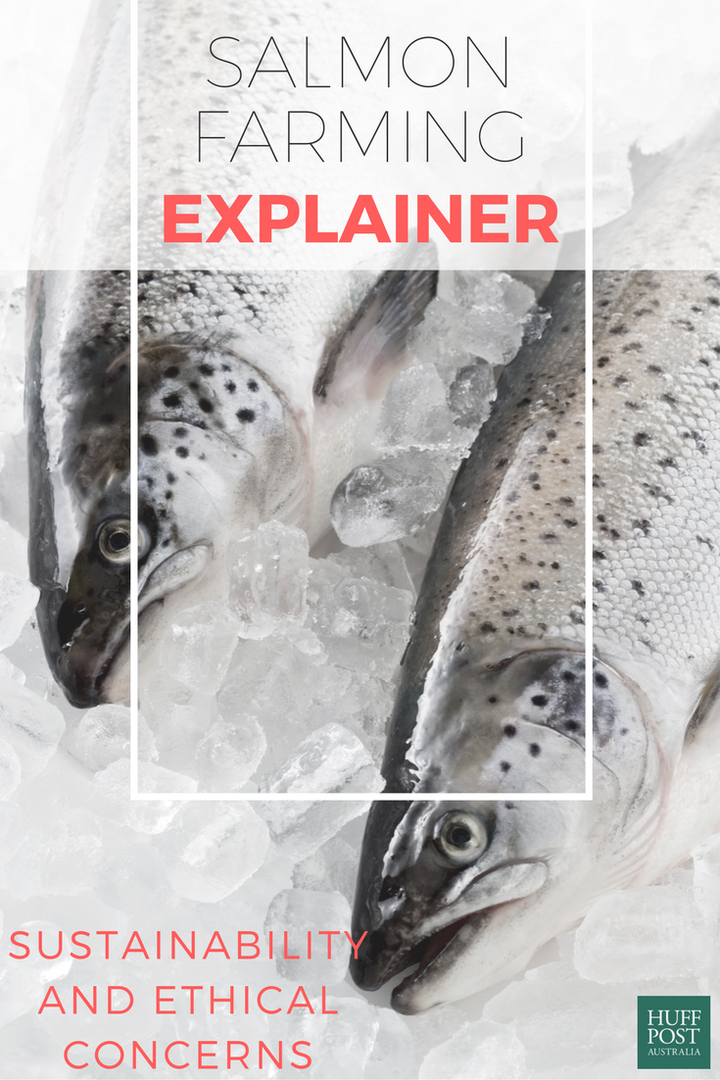
These are issues which will not go away. In fact, if we don't address the problems inherent to salmon farming, we're not addressing our environment's needs and something bad is going to happen -- if it hasn't already.
To get a deeper understanding about salmon farming in Australia, its effects and what solutions we can implement to ensure long-term sustainability, The Huffington Post Australia spoke to three sustainability and aquaculture experts.
Here are the main issues, explained.
Salmon feed
The feed which is fed to salmon is one of the main issues of farming affecting the environment due to two reasons: its ingredients and the consequences of leftover feed settling to the seafloor.
First, let's talk about what's really in (and what's not in) salmon feed.
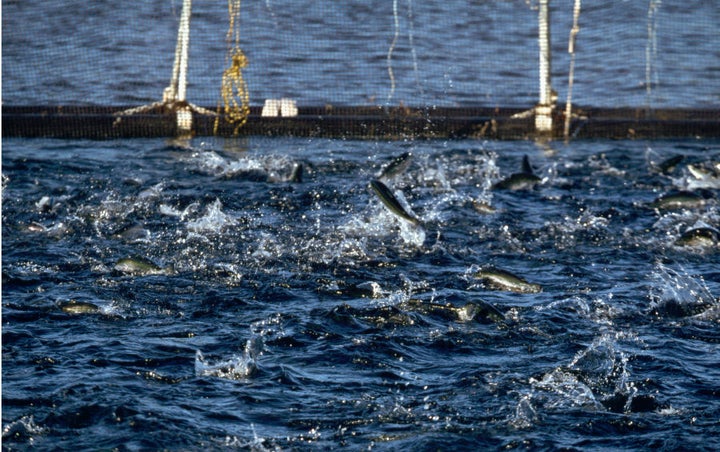
In the wild, adult salmon eat other fish, squid, eels and prawns. According to associate professor Kathy Schuller, who researches omega-3 fatty acid metabolism and oxidative stability in aquaculture species at Flinders University, a salmon's diet is what produces the quality of salmon we eat.
But farmed salmon aren't being fed a diet mostly of other marine animals -- and depending on your viewpoint, this is both a good and bad thing.
One of the major concerns that relates to salmon farming is the amount of marine ingredients that go into a salmon diet or an aquaculture diet.
"Around the world, where fish are being farmed, they're being fed ingredients that are derived from terrestrial plants and animals. And those ingredients are partially replacing ingredients that would originally have come from small fish in the marine environment," Schuller told The Huffington Post Australia.
"The aim in doing that is to reduce the pressure on the populations of the small fish in the marine environment. By changing the diets that are fed to the farmed fish, we can reduce the pressure on, for example, sardines that are normally caught to feed larger fish."
This change in feed to reduce the impact on the marine environment is a great change, said Graham Mair, professor and director of Marine Sciences at Flinders University, who specialises in aquaculture and genetic breeding programs.
"One of the major concerns that relates to salmon farming is the amount of marine ingredients that go into a salmon diet or an aquaculture diet," Mair told HuffPost Australia.
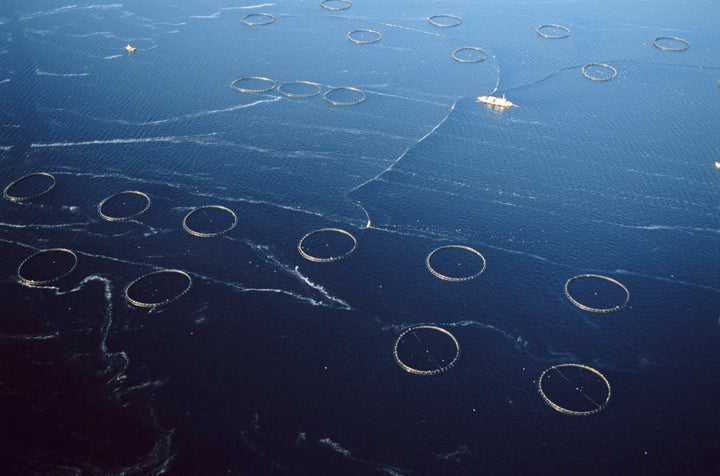
"Traditionally when aquaculture started, you might have up to 90 percent of the diet for salmon or other fish was made up of fish who were harvested from the oceans. For example, fish meal that might come from Peruvian anchovies.
"The industry has now done a lot to bring that down. Now it's only about 30 percent. So the rest of it is coming mostly from plants and sometimes by-products of livestock industries, which are already being harvested so they're more sustainable sources."
Mair also highlights that the amount of salmon feed needed for one kilogram of salmon is much less than needed for other animal proteins.
"When you look at that, the argument for aquaculture is very strong because the food conversion of fish and seafood is very good," Mair said.
"Modern day food conversion for salmon is 1.2 or 1.3, which means you have to give it 1.3 kilos of food to get one kilo of salmon. Whereas most other forms of primary product are much higher than that."
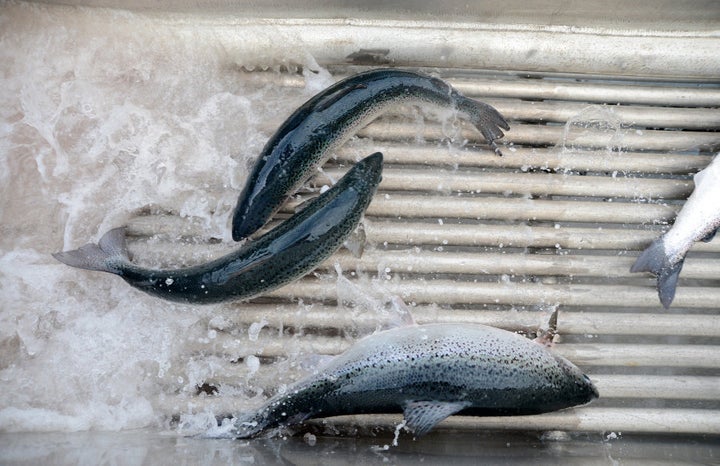
While a mixed fish feed of plant and land animal by-products is reducing the need for other fish like sardines and anchovies, Schuller said this diet can compromise the nutritional profile of salmon, which are a 'super food' for their long chain omega 3 fatty acids.
"These terrestrial plants and animal ingredients which are used to partially replace marine fish ingredients do have different fatty acid profiles. Sardines, for example, are very rich in long chain omega 3 fatty acids. Whereas canola oil, which has been used as a replacement for fish oil in feeds for farmed fish, doesn't contain those long chain marine-type omega 3 fatty acids," Schuller said.
"Canola oil still has omega 3 fatty acids but they're not the long chain ones, and it's the long chain ones that are the ones particular recognised for their human health benefits. That's why it's recommend that people eat more seafood, because they get the long chain omega 3 fatty acids."
By using canola oil, there is a reduction in these marine type fatty acids in the edible part of a farmed fish, Schuller explains.
"Many aquaculture producers feed their fish for most of their lifetime on a feed that contains canola oil, but for a short time before they send their fish to market, they transfer their fish back to a feed that contains mostly fish oil," Schuller said.
"That means that the flesh of the farmed fish then take on the same fatty acid profiles as the wild caught fish. So you can boost the levels of these long chain omega 3 fatty acids in the flesh of the farmed fish."
Then comes the issue of farmed salmon's flesh colour, which is actually grey if the salmon is not fed feed which includes astaxanthin, the supplement that makes the salmon flesh red.
The consumer expects their salmon to be red, and that's why the salmon farmers include the astaxanthin in the feed for the farmed salmon.
"In the wild, salmon obtain this astaxanthin pigment from algae and seaweeds at the bottom of the food chain, so astaxanthin is a natural compound found in the flesh of the fish and gives them the red colour," Schuller said.
In Tasmania, the astaxanthin in the salmon feed comes in the form of chemically synthesised astaxanthin, which Schuller said is "exactly identical to what would be found in the food chain in the wild".
"There's no difference at all. The consumer expects their salmon to be red, and that's why the salmon farmers include the astaxanthin in the feed for the farmed salmon," Schuller said.
Some studies also suggest that salmon farming increases mercury contamination in wild fish.

Feed and effluent waste
The second part of the feed issue is when excess salmon feed (and excrement) settles to the bottom of the sea pens and seafloor, which can negatively affect the water oxygen levels, leading to mass fish deaths.
In the past year alone, 21,000 tonnes of fish feed has ended up in Macquarie Harbour, the Environment Protection Authority (EPA) told Four Corners.
According to David Booth, professor of Marine Ecology and director of the Centre for Environmental Sustainability at UTS and President of the Australian Coral Reef Society, this is a concerning issue for the environment.
"There are many issues with salmon farming. Overall, I'm very concerned," Booth told HuffPost Australia.
"It's a huge industry and I've been asked to comment before on the Macquarie Harbour situation in the West Coast of Tasmania, which is a real worry.
"The lack of flushing, and it's a harbour that naturally has an organic deposit from upstream, so quite often they get small anoxic bits. And when you add salmon all defecating, not only does it kill the salmon but it really makes a mess of our waterway. It's a beautiful place otherwise."
I'm very concerned about the collateral damage of sea pens on the environment.

Mair, however, says the cause for mass fish kill is caused by the nature of Macquarie Harbour.
"It's not in the interest of the salmon industry to push the environment so far. [Four Corners] did mention there was a fish kill in Macquarie Harbour, and that would have been caused by a turnover due to the particular morphology and topography of the Harbour," Mair said.
"What can happen in aquaculture is you get anoxic water, so the bottom water gets very low in oxygen, and if a storm comes along it mixes up the low oxygen water and it can potentially enter the fish cage."
Regardless, Booth believes near-shore sea pens are not the place for sustainable salmon farming.
"I'm not a business person, but for me, one of the main things not taken into account is where you're putting the farms," Booth said.
"Does all salmon farming have to occur in a natural river? I know sea pens are very economical for them and they're able to make huge profit, but I'm very concerned about the collateral damage of sea pens on the environment.
"It's not just salmon, it's also tuna in South Australia that's being raised in those pens."
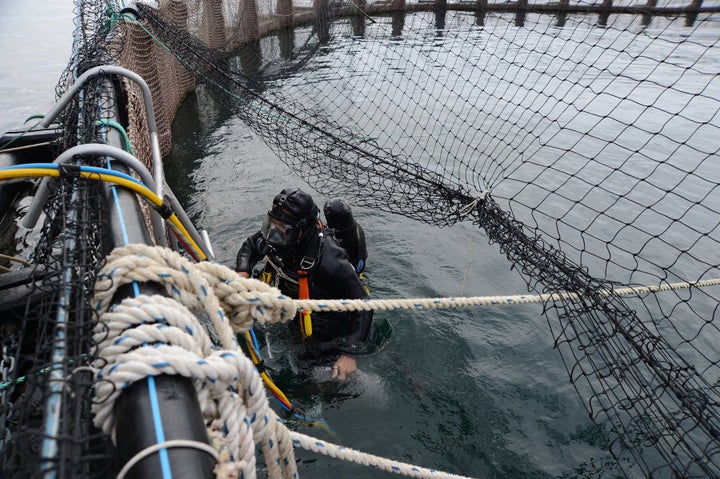
Modified salmon
Salmon do not thrive in warm water, hence why they are farmed in the coolest part of Australia. Even still, the Tasmanian waters are too warm for salmon, which is why they have been modified to suit the climate.
"The interesting thing about salmon farming is that how much it's taken off. It's almost worth more than the entire rest of the Australian fishing fleet. And what is it? It's an introduced species that's come into Australia which has been farmed in a situation where it's in our lakes and rivers -- it's not onshore in a completely contained system, it's in these pens," Booth said.
"Australia unfortunately is not a very productive country, fish wise. We're too tropical. We rank around 56th in the world in terms of wild fish catch. New Zealand is around seventh."
They're racing climate change in a way. My guess is the industry will naturally die off as the ocean warms, in Australia anyway.
Through selective breeding, it's possible to choose advantageous traits and breed salmon which suit Tasmanian conditions. Four Corners also reported that Tassal, through intensive breeding, can manipulate salmon so they carry both testicles and ovaries.
"It's very sad for Australia that by far our major fish product has been introduced from elsewhere," Booth said.
"The other thing is climate change is a factor here. Of course the reason they have the salmon is Tasmania is it's the coldest part of Australia but it isn't cold enough. I've spent time in Canada and there are many species of salmon that wouldn't survive in Australia, it's too warm.
"They're racing climate change in a way. My guess is the industry will naturally die off as the ocean warms, in Australia anyway."
Ethics
While salmon farming can alleviate stress on the environment in one sense, if you're concerned about animal welfare, how the salmon are kept in sea pens and the mass death of salmon may be a deciding factor on whether you feel comfortable consuming salmon.
"To me, how the salmon are kept and the fact that they have these mass deaths is also a concern. They're animals as well and they deserved to be treated ethically," Booth told HuffPost Australia.
"For a small experiment in a university, if I bring one fish in to look at for a week and put it back, I have to fill out a huge amount of ethics forms, and I wonder if these companies are doing similar things for the millions of salmon they kill.
"Their profit and loss ledger sheet doesn't include the cost for environment. If it did, maybe they wouldn't be making such a high profit.
"There's that issue, but also the effect on the natural environment. And to my knowledge, it doesn't do very well at all."
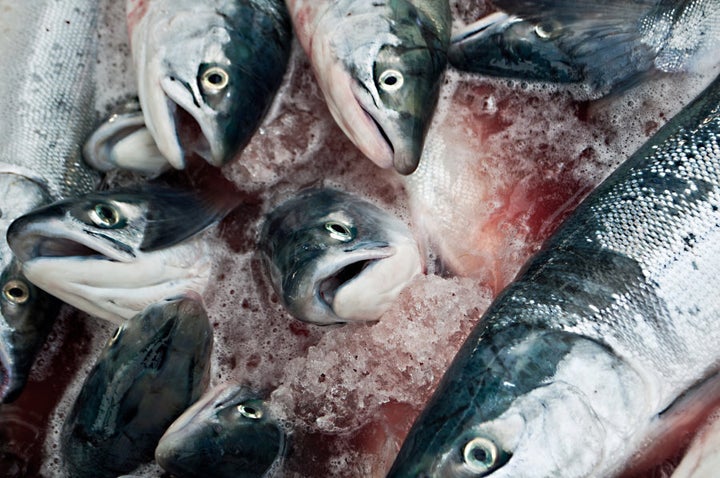
Solutions
While it's important to address the inherent problems that come with salmon farming, it's equally important to explore ways in which salmon farming (and consuming) can be made more sustainable and ethical.
"We can farm fish sustainably, there's no doubt about that. But we need to look at the science and the scientists who are doing the work in Macquarie Harbour," Mair said.
Here are ways to make salmon farming more sustainable and ethical.
1. Eat wild salmon, occasionally
To increase salmon quality of life -- and to reduce the amount of waste from uneaten feed and salmon faecal matter on the seafloor -- one option is to eat wild salmon and other wild seafood, but in moderate amounts.
"If you're trying to be nicer to the animals, I like wild seafood. Just until the second they're caught, they are living naturally as animals," Booth said.
Their profit and loss ledger sheet doesn't include the cost for environment. If it did, maybe they wouldn't be making such a high profit.
"Aquaculture is a bit more like pig farming unfortunately, they're being bred in captivity. To me, if there's a good sustainable wild fish, it's the best. With wild fish, all you have to do is catch the fish and they look after themselves.
"If you manage it correctly and allow them to breed and not take too many, it's not perfect -- we are here on earth unfortunately and we do have a big impact -- but to me that is extremely ethical compared to pig or cow farming. I'd like to see a robust, well managed wild fishery as much as possible."
However, the quantity is key, as too much pressure on wild fisheries is also unsustainable.
"It's generally accepted now that our opportunity to increase the amount of seafood that we harvest from our wild catch fisheries has a very limited opportunity to expand. In reality, it's probably already at its peak and if we don't manage it properly we'll actually decline," Mair said.
"There's a corresponding effect that if you limit the expansion of aquaculture through regulation or economy, you actually increase the pressure on wild catch fisheries, so you potentially damage wild resource."
"Of course there are an enormous amounts of seafood and if we did that, we'd be importing more than 80 percent of our seafood. That's another argument for having salmon farms, I suppose," Booth added.
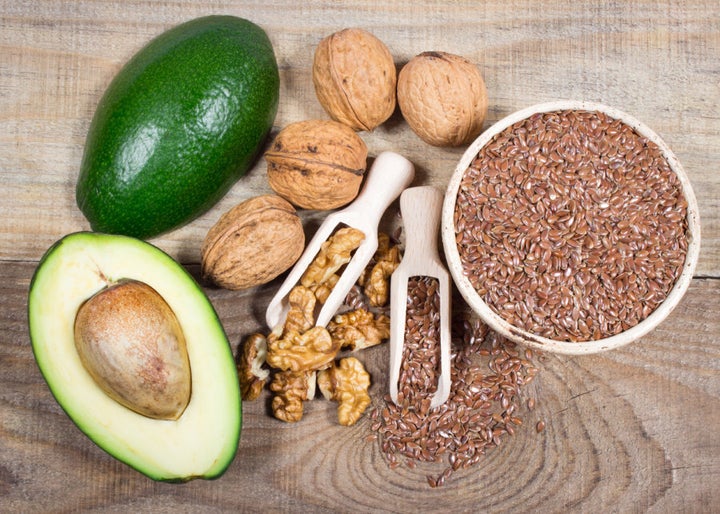
Another option is to stop eating salmon or seafood altogether.
"That might depend on what you believe the human race needs to consume. Obviously if you're a vegetarian or vegan, you're probably quite happy to do that," Mair said.
"We actually exploit a very small proportion of the world's ocean relative to the proportion of land we exploit for agriculture. There are much more opportunities to expand our food products in the ocean than there is on land. In the ocean we can expand to new areas."
2. Research the carrying capacity of the environment
"There are always things we can do. Generally speaking, for most sea cage aquaculture, one of the things we can do to reduce the impact," Mair said.
One of Mair's key points in making salmon farming more sustainable is to understand the carrying capacity of the environment, and to farm accordingly.
"If you understand the carrying capacity of the environment, then you can regulate the density of aquaculture such that the impact on the environment is negligible. That's where science comes in -- you have to understand what's happening today and what's happening in the future," Mair said.
"There is a risk you can exceed the carrying capacity of the environment, and I believe that's the concern around Macquarie Harbour."

3. Expand salmon farming offshore (and on land)
Another option to help promote sustainability is to move salmon farming from near-shore to further offshore, or even onto land.
"The oceans are big and there are opportunities to expand in different directions. You can bring it onto land, or take it further offshore where your impact upon the environment is much less because you're farming in an open body of water with wave action and tides to carry the waste off into the great, big, blue beyond," Mair said.
"Again, that's quite capital intensive because you need to have a physically stronger system to manage the greater challenges of wind and wave action, and you've got further to travel to shore.
"As the industry continues to expand, I believe it will eventually have to move out into other environments because at some point all the available nearshore environments will be taken."
4. Develop integrated multi-trophic aquaculture
The main cause for concern with salmon farming is the waste produced from uneaten feed or faecal material, and one way to reduce this is to introduce marine species which consume this waste.
"The other way in which we can make salmon farming more sustainable is to try to develop integrated multi-trophic aquaculture (IMTA). That's where you grow other forms of aquaculture species to utilise and remediate the waste that could be coming out of salmon farming," Mair said.
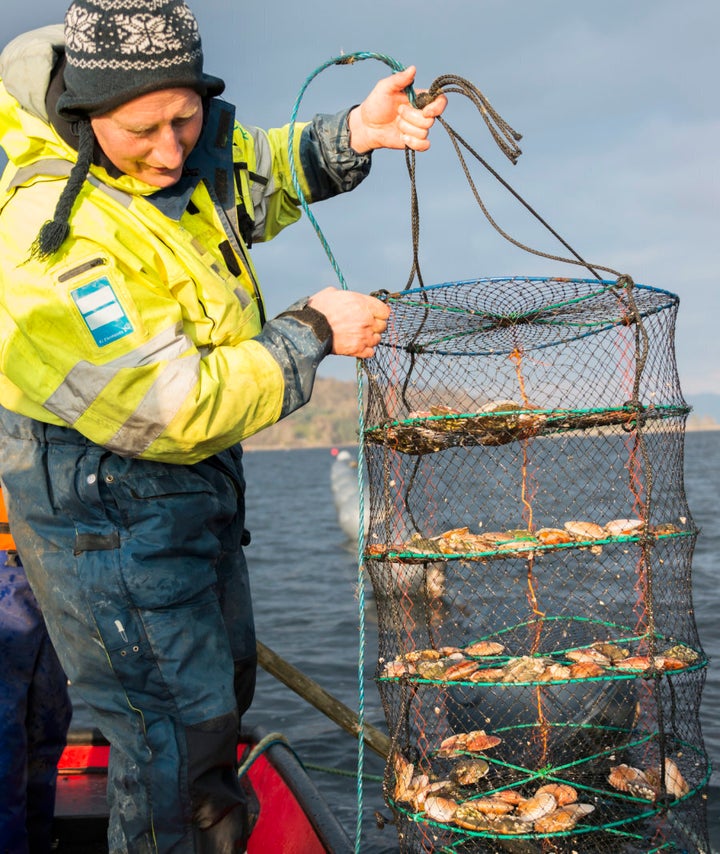
"An example of IMTA in relation to a fish cage is if you have a salmon cage (and the waste from which will be uneaten food or faecal material which can fall to the bottom of the cage and settle on the substrate below, or it could be carried away from the cage in a current) -- you could farm something like a sea cucumber which would actually consume the waste material underneath the cage."
Mair explains that salmon farmers could also put a particulate feeder adjacent to the cage so the smaller particles can be filtered out by a filtered feeding organism like a mollusc, oyster or mussel.
"In addition to particulate waste, you could have dissolved nutrients. Some of the fish waste is dissolved into the water and those nutrients can be utilised by seaweed. You could also have seaweed racks of frames around the cage so at least some, if not all, of the waste is actually utilised and remediated by other aquaculture products," Mair said.
"If we could develop those systems I think it could portray a very positive image of the industry. But in reality, I think it still requires a lot more research to work out exactly how we can do that. There's not many examples of this being done commercially yet. But in 10 to 15 years' time we might see more of that."
From here on out, the focus must be on finding more sustainable ways to farm and eat salmon and other fish, at both a consumer and business level.
They're taking and not giving back. I don't see a lot of consideration for the environment at this point.
"Aquaculture is here to stay, not that this comforts people who don't support it," Mair said.
"We either don't meet the demand or we have to expand aquaculture. I think it's beholden on us to develop and provide as much support as we can to the industry, which in the case of Australia certainly wants to develop sustainability and, by and large, it is."
"There's pros and cons, and I personally think the salmon farming industry -- which is making a huge profit of hundreds of millions of dollars -- needs to put more back," Booth said.
"They're taking and not giving back. I don't see a lot of consideration for the environment at this point."
Click below to follow HuffPost Australia on Snapchat!
